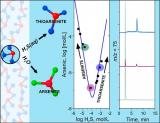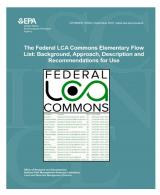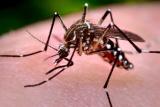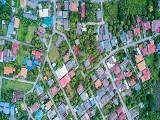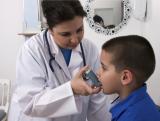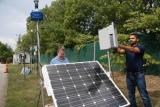Sustainable and Healthy Communities Research Highlights
The Sustainable and Healthy Communities (SHC) Research Program emphasizes research and technology to support cleaning up contaminated sites, protecting associated communities, and restoring ecosystems that provide benefits to those communities. It emphasizes solutions-driven science to support decisions that will revitalize the nation’s communities and make them more resilient to severe weather and other environmental incidents.
This page contains highlights of recent research results, including products, peer-reviewed journal article, and EPA reports. The highlights focus on three topic areas emphasized in the Sustainable and Healthy Communities Strategic Research Action Plan 2019-2022.
On this page:
- Contaminated sites (e.g., Superfund, Areas of Concern)
- Waste and Sustainable Materials Management
- Healthy and Resilient Communities
Contaminated Sites
Innovations for Understanding Complex Surface-and Groundwater Interactions
High-resolution fiber-optic technologies are familiar to most of us in the context of upgrading home internet services. EPA researcher Dale Werkema and his collaborators are advancing the use of such technologies to study the complex dynamics of stream hydrodynamics, particularly related to groundwater and surface water flow and exchange. In their study, Actively heated high-resolution fiber-optic-distributed temperature sensing to quantify streambed flow dynamics in zones of strong groundwater upwelling, they demonstrate the innovative use of active high-resolution fiber-optic temperature sensors to advance the understanding of ground- and surface water interactions in streams. The new techniques have implications for studies to inform a host of activities, including improving habit for native fish, stream restoration, and containing and mitigation contamination.
Developing New Ways to Study and Mitigate Arsenic Contamination in Groundwater
Different conditions, including the presence of other chemicals and the pH of the water, can influence both the movement and toxicity of arsenic in groundwater. In their publication, Thioarsenite Detection and Implications for Arsenic Transport in Groundwater, EPA researchers present findings from their work on advancing new methods for detecting and analyzing a form of arsenic found in groundwater systems containing sulfur. What they are learning is part of a larger research effort to help contaminated site managers protect existing groundwater sources or return contaminated sites back to productive use.
Read more about EPA's study on detecting and analyzing arsenic found in groundwater.
EPA Innovation: Presenting the Dual-Domain Porosity Apparatus (DDPA)
To advance contaminated site and groundwater research, EPA researcher Dale Werkema and colleagues are developing a new technology to observe and test what is happening in the tiny pore spaces where water and sediment meet. In their paper, The Dual‐Domain Porosity Apparatus: Characterizing Dual Porosity at the Sediment/Water Interface, they present results of a field-scale experiment of DDPA conducted at Snake Pond in MA. The new design advances a critical need to for understanding contaminant transport and reactive biogeochemical processes in zones of groundwater and surface‐water exchange.
Read more about EPA's contaminated site and groundwater research study.
Waste and Sustainable Materials Management
Food Waste Reduction in Military Kitchens
EPA researchers worked with two military dining facilities in Fort Jackson South Carolina to pilot food waste prevention technology in their report, Food Waste Reduction in Military Kitchens A Tracking Technology Demonstration at Fort Jackson. Researchers worked with base and kitchen staff to utilize the Leanpath tool, which weighs and categorizes food waste. Leanpath had already seen success for companies such as IKEA but had not yet been used in military kitchens. Staff in the dining facility kitchens were able to use the data to learn which foods were being wasted, what patterns were allowing food to go to waste, and which waste minimalization solutions were a good fit. After 3 months, over 3,500 pounds of food waste was diverted from the landfill through changes in menu planning and kitchen practices, as well as donations to food recovery groups. Findings from this study can be used in institutional kitchens across the country to save money and reduce food waste.
Read more about EPA's food waste study.
Standardized Elementary Flow List for the Federal Life-Cycle Assessment Commons
EPA has created a new standard list of resources and emissions for use in models that quantify potential life cycle impacts of products. This list, called the Federal LCA Common Elementary Flow List (FEDEFL), has been adopted by other federal agencies as a foundational component of life cycle data that is shared through the common interagency data portal, the LCA Commons. The FEDEFL is available for an life cycle assessment practitioner to use and will continue to be maintain by EPA and federal partners to accommodate continuing advances in life cycle data.
Read EPA's standard life cycle assessment report.
Healthy and Resilient Communities
Buzz off? Exploring how coastal wetlands can buffer disease-causing mosquitoes in Puerto Rico
EPA researchers studied how the natural habitats of the San Juan Bay Estuary might buffer the proliferation of the disease-causing mosquito Aedes aegypti. In Linking Wetland Ecosystem Services to Vector-borne Disease: Dengue Fever in the San Juan Bay Estuary, Puerto Rico, they present findings that San Juan Bay Estuary wetlands, especially mangroves, can provide a protective effect against vector-borne diseases in coastal urbanized neighborhoods.
Read more about EPA's wetland ecosystems study.
Gone Fishing: Using Innovative Methods to Investigate Trout Habitat
EPA researcher Dale Werkema and his collaborators used high resolution fiber-optic sensors to investigate a two-kilometer beach of the coastal Quashnet River in Cape Cod, MA to advance the understanding of how a complex mix of habitat features related to geology, geomorphology, and groundwater geochemistry contribute to spawning habitat by brook trout (Salvelinus fontinalis). In their study, Hydrogeochemical controls on brook trout spawning habitats in a coastal stream, they identified potential critical components of coastal stream systems that provide brook trout with the oxygen rich water their eggs need to survive, such as ground-water discharge points free from substantial buried organic materials.
Read EPA's study about the use of new technology to understand the habitat of trout.
To Your Good Health: Studying Residential Neighborhood Environments
EPA researcher Wei-Lun Tsai and her collaborators are examining the relationship between aspects of natural environments in residential areas and self-reported general health in woman. In their study, How do natural features in the residential environment influence women's self-reported general health? Results from cross-sectional analyses of a U.S. national cohort, they identify such influences as climate, air quality, social support, and physical activity on the relationship between general health and the natural environment. The results have the potential to inform community planning and investments in a neighborhood’s natural environment to improve health benefits for residents.
Read more about EPA's health study.
Is Food Type Important for Post-Ingestion Bioaccessibility of Contaminants in Soil?
EPA researcher James Starr and his collaborators studied the influence of children’s diets on the bioacessibility (mobilization) of polychlorinated biphenyls sorbed to ingested soil. In their study, Is food type important for in vitro post ingestion bioaccessibility models of polychlorinated biphenyls sorbed to soils?, they demonstrated that levels of organic carbon (a component of soil) and dietary fat are the most significant bioaccessibility predictors. The study suggests that fat intake may be the only dietary input needed when modeling the bioaccessibility of polychlorinated biphenyls sorbed to ingested soil.
Helping Children Breathe Easier
EPA researcher Stephen Vesper and his collaborators studied the relationship between indoor and outdoor air pollution and decreased lung function in children with asthma. In their study, Indoor particulate matter and lung function in children living near roadways, they determined that for asthmatic children, indoor particulate matter (PM) is a better indicator of lung function than outdoor PM. Their results suggest the need to help children avoid indoors environments with smoldering organic PM sources, such as cigarette smoke, wood, and incense.
Read EPA's study about the relationship between indoor air quality and children with asthma.Exit
Combining Modeling and Monitoring Data for Community Scale Air Quality Characterization
EPA researcher Vlad Isakov and his collaborators developed an air quality modeling approach to help pinpoint how proximity to major transportation hubs—such as highways, ports, and rail yards—can impact local air quality. In their study, Combining Dispersion Modeling and Monitoring Data for Community Scale Air Quality Characterization, they used a data fusion approach to identify local air pollution hot spots in the study area of southeast Kansas City. This approach helped them improve emission inputs for dispersion modeling to determine contributions from local and regional air pollution sources. This has implications for researchers, air quality managers and communities impacted by emissions from mobile sources
Read more about EPA's air quality study.
Calculating the Economic Benefits of a Day at The Beach
Beaches are important economic resources for coastal communities that rely on income from tourism, so closures due to poor water quality come with economic costs. But how much? EPA researchers developed models to estimate the value of a beach day, as well as the value lost during closures due to bacterial contamination, in their project, Valuing coastal beaches and closures using benefit transfer: An application to Barnstable, Massachusetts. “The results indicate a high value for beaches as a public resource and show significant losses to the town when beaches are closed due to an exceedance in bacterial concentrations,” they note.
Read more about EPA's valuation study of beaches.
Quantifying Recreational Use of an Estuary: A Case Study of Three Bays, Cape Cod, USA
Americans take over 900 million trips to coastal areas each year, spending at least $44 billion per year on those trips. However, there isn’t much information on how these activities and economic values are affected by poor coastal water quality. In their study, Quantifying Recreational Use of an Estuary: A Case Study of Three Bays, Cape Cod, USA., EPA researchers developed a simple method to estimate the number and type of recreational users visiting estuaries, which are waterbodies that can be affected by poor water quality. They piloted their method of periodic counting at the Three Bays estuary system in Cape Cod, Massachusetts. This technique and study can be used in coastal communities across the United States to estimate the number of visitors to different coastal access points, which can then be used to better understand the impact changes in water quality have on coastal recreation.


